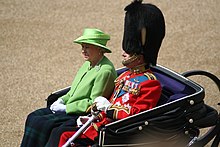House troops

Domestic troops were, in the original sense, troops intended to serve the person of a (mostly monarchical ) head of state and in particular responsible for his personal safety. Today house troops can still be found in almost all royal houses in the world, the best known are v. a. the British Household Division , the Spanish Guardia Real or the Papal Swiss Guard . With the exception of the latter, domestic troops are now mostly regular units or associations that, in addition to their representative, also perform military tasks, but are no longer responsible for the personal safety of the members of the ruling house (this task is now performed by professional bodyguards from the ranks of the police or Secret Service taken over). Members of ruling royal houses usually hold honorary military ranks in the associations of their respective household troops, and such honorary ranks are often awarded as an award for foreign princes.
Historical
Domestic troops were already used by the Persian kings and their satraps ; later in Rome , among the early Caesars as Praetorians or bodyguards of the emperors, among the later as copiae palatinae. The Turkish sultans had domestic troops such as B. the Spahis , Janissaries and Thoptschis .
- In France, domestic troops were formed in 1493 as orderly companies , which were separated from the troops in 1671 by Louis XIV as Maison militaire du roi ; as such they existed until the revolution and from 1816 to 1830. Napoléon III. put the Cent-Guard in their place.
- In Brandenburg domestic troops were formed in 1542 as a satellite guard , which was disbanded in 1713. The Castle Guard Company (emerged in 1861 from the Guard Sergeant Company founded in 1829) served Prussia's kings until 1918 .
- The Arcièren Life Guard existed in Austria .
- The Hartschiere existed in Bavaria .
- In Russia in the 16th and 17th centuries, the Druschine and Strelitzen served as domestic troops. Peter I dissolved all of these and established a bodyguard from his former playmates, which later became the Preobrazhensky Guard Regiment .
Individual evidence
- ↑ See on this: House troops of the French king